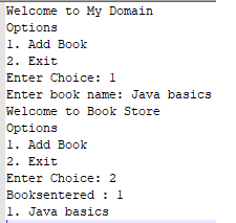JavaのEJB
Ejb は Enterprise Java Bean コンポーネントとして示され、サーバー側ソフトウェア コンポーネントとも呼ばれます。主にアプリケーションのビジネス ロジックとして使用されます。ランタイム環境に使用される Web コンテナには、ソフトウェア コンポーネント、コンピュータ セキュリティ、サーブレット ライフサイクル管理、トランザクション処理、および Web サービスが含まれます。EJb は、コンピュータ ネットワークのサーバー側で実行される Java プログラミング言語で書かれたアーキテクチャ スタイルであるため、アプリケーションではクライアント/サーバー モデルに従っています。また、ejb は Web コンポーネントをクライアント側に配布するための Java Bean 技術であり、複数の Web アプリケーションで再利用可能なコンポーネントと呼ばれる機能を持っています。
無料ソフトウェア開発コースを始めましょう
Web 開発、プログラミング言語、ソフトウェア テスト、その他
構文:
Java プログラミングにおける EJB モデルの基本構文は次のとおりです。
import javax.ejb.*;
import java packages;
class classname
{
Main method()
{
-----Some programming logics----
}
}上記のコードは、ejb パッケージを使用してアプリケーションを開発するための基本的な手順です。
Java Works で EJB を使用するには?
- EJB では、Java Bean クラスは ejb 仕様に複数のアノテーションを使用します。これは、ビジネス目的に基づいてユーザー要件を満たすのに役立ちます。EJB にはさまざまなバージョンのセットがあり、JNDI のような機能に従っています。 (Java ネーミング ディレクトリ インターフェイス)。サーバー jndi 内のリソースの 1 つはディレクトリ サービスであり、ejb、データ ソース、JMS キュー サービスなどのリソースの検索または割り当てに使用されます。サーバーには jndi リソースのデフォルトのスキーム名がありますが、構成部分の名前を変更した場合は上書きする必要があります。
- EJB は Java Bean 上で動作します。 1. セッション Bean と 2. メッセージ駆動型 BeanSession Bean の 2 つの異なるタイプがあります。セッション Bean はクライアントとサーバーの対話に使用されます。クライアントによってプログラム的にアプリケーションのビジネス ロジックがカプセル化されます。呼び出しはローカル マシンまたはリモート マシンによって実行され、Bean はクライアントによって Web サービスの助けを借りて使用されます。セッション Bean は 3 つの異なるカテゴリになります。1. ステートレス Bean、2. ステートフル Bean、および 3. シングルトン.ステートレス Bean。クライアントがこれらのタイプの Bean を使用する場合、Web コンテナーには永続的な状態がないため、比較するとスレッドセーフなパフォーマンスが非常に高速です。ステートフル Bean に。これらの Bean は同時に複数のクライアントと共有されます。
- ステートフル Bean はコンテナに状態を保存できます。クライアントがセッションを終了すると、これらの状態もサーバー内で破棄されます。 Singelton Bean には、アプリケーションのライフサイクル全体に対して 1 つのインスタンス セッションがあります。これらの Bean は複数のクライアントと状態を共有しました。これらの Bean はスレッドセーフであるため、開発者はより簡単に使用でき、ステートフル Bean と比較してパフォーマンスも高速です。
- Message Driven Beans(MDB) は、JMS メッセージ リスナーと同様に非同期メッセージのタイプとして使用される Bean のタイプですが、メッセージの応答をイベントではなく JMS メッセージとして受け取ります。メッセージを受信するたびに、コンテナがその後の処理のために onMessage() メソッドを使用して MDB Bean を呼び出すたびに、jndi サービスを使用してメッセージをマップできます。 onMessage() メソッドを使用する MDB のプロセス全体が 1 つのトランザクションになります。メッセージ処理がロールバックであると仮定すると、受信側メッセージは再び再配信されます。
Java で EJB を実装する例
以下に挙げる例を示します:
例 #1
インターフェース:
package JPAEJB;
import java.util.List;
import javax.ejb.Remote;
@Remote
public interface CustomerInterface {
void addBooks(String name);
List getBooks();
}実装:
import java.util.ArrayList;
import java.util.List;
import javax.ejb.Stateless;
import JPAEJB.CustomerInterface;
@Stateless
public class CustomerClass implements CustomerInterface {
List<String>books;
public CustomerClass() {
books = new ArrayList<String>();
}
public void addBooks(String name) {
books.add(name);
}
public List<String> getBooks() {
return books;
}
}顧客インターフェース:
import JPAEJB.CustomerInterface;
import java.io.BufferedReader;
import java.io.FileInputStream;
import java.io.IOException;
import java.io.InputStreamReader;
import java.util.List;
import java.util.Properties;
import javax.naming.InitialContext;
import javax.naming.NamingException;
public class CustomerInterfaceImplem {
BufferedReader brConsoleReader = null;
Properties p;
InitialContext c;
{
p = new Properties();
try {
p.load(new FileInputStream("jndi.properties"));
} catch (IOException ex) {
ex.printStackTrace();
}
try {
c = new InitialContext(p);
} catch (NamingException ex) {
ex.printStackTrace();
}
brConsoleReader =
new BufferedReader(new InputStreamReader(System.in));
}
public static void main(String[] args) {
CustomerInterfaceImplem cust = new CustomerInterfaceImplem();
cust.testStatelessEjb();
}
private void show() {
System.out.println("Welcome to my domain");
System.out.print("Options \n1. Add the Books\n2. Exit \nEnter your Choice: ");
}
private void StatelessEjb() {
try {
intc = 1;
CustomerInterface cust =
(CustomerInterface)ctx.lookup("CustomerInterface/remote");
while (c != 2) {
String books;
show();
String str = brConsoleReader.readLine();
c = Integer.parseInt(str);
if (c == 1) {
books = brConsoleReader.readLine();
cust.addBooks(books);
}elseif (c == 2) {
break;
}
}
List<String>books1 = cust.getBooks();
System.out.println(books1.size());
for (inti = 0; i<books1.size(); ++i) {
System.out.println((i+1)+". " + books1.get(i));
}
CustomerInterface cust1 =
(CustomerInterface)ctx.lookup("cust/remote");
List<String>books2 = cust.getBooks();
System.out.println(books2.size());
for (inti = 0; i<books2.size(); ++i) {
System.out.println((i+1)+". " + books2.get(i));
}
} catch (Exception e) {
System.out.println(e.getMessage());
e.printStackTrace();
} finally {
try {
if(brConsoleReader !=null) {
brConsoleReader.close();
}
} catch (IOException ex) {
System.out.println(ex.getMessage());
}
}
}
}サンプル出力:

例 #2
Web サービスの EJB:
package JPAEJB;
import java.util.List;
import Customers.CustomerInterfaceImplem;
public class Ejbclients{
public static void main(String[] args) {
for(CustomerInterface cust:getBooks()) {
System.out.println(cust.getBooks());
}
}
private static List
<CustomerInterface> getBooks() {
CustomerInterfaceImplem s =
new CustomerInterfaceImplem();
CustomerInterface c =
s.getCustomerInterfacePort();
return c.getBooks();
}
}例 #3
EJB セキュリティ:
import javax.ejb.*
@Stateless
@DeclareRoles({"customer""books"})
public class CustSecurity implements CustomerInterface {
@RolesAllowed({"books"})
public void delete(CustomerInterface cust) {
System.out.println("customer delete the books");
}
@PermitAll
public void showBooks(CustomerInterface cust) {
System.out.println("customer viewed the books");
}
@DenyAll
public void deleteAll() {
System.out.println("customer delete all the books in libraries");
}
}セキュリティ XML:
<?xml version="1.0"encoding="UTF-8"?> <!DOCTYPE sun-ejb-jar PUBLIC "-//Sun Microsystems, Inc.//DTD Application Server 9.0 EJB 3.0//EN""http://www.sun.com/software/appserver/dtds/sun-ejb-jar_3_0-0.dtd"> <ejb-jar> <security-role-mapping> <role-name>customer</role-name> <group-name>customer-groups</group-name> </security-role-mapping> <security-role-mapping> <role-name>Books</role-name> <group-name>Books-group</group-name> </security-role-mapping> <enterprise-beans/> </ejb-jar>
説明: 上記の 3 つの例は、ejb の異なる機能を使用した同じ出力です。最初に使用する例は、顧客が jndi(Java ネーミング ディレクトリ インターフェイス) を使用して書籍を追加および削除します。2 番目の例は、使用します。顧客向けの Web サービスは Web を通じて操作を実行しました。追加のセキュリティを使用した最後の例です。
結論
一般に、EJB はビジネス ロジック アプリケーションの外部のインターフェイスとして機能します。他のビジネス ロジック フレームワークと比較して、セキュリティ面でブラウザ互換性機能が優れています。また、システムレベルのトランザクションも維持します。
以上がJavaのEJBの詳細内容です。詳細については、PHP 中国語 Web サイトの他の関連記事を参照してください。

ホットAIツール

Undresser.AI Undress
リアルなヌード写真を作成する AI 搭載アプリ

AI Clothes Remover
写真から衣服を削除するオンライン AI ツール。

Undress AI Tool
脱衣画像を無料で

Clothoff.io
AI衣類リムーバー

Video Face Swap
完全無料の AI 顔交換ツールを使用して、あらゆるビデオの顔を簡単に交換できます。

人気の記事

ホットツール

メモ帳++7.3.1
使いやすく無料のコードエディター

SublimeText3 中国語版
中国語版、とても使いやすい

ゼンドスタジオ 13.0.1
強力な PHP 統合開発環境

ドリームウィーバー CS6
ビジュアル Web 開発ツール

SublimeText3 Mac版
神レベルのコード編集ソフト(SublimeText3)

ホットトピック
 7940
7940
 15
15
 1652
1652
 14
14
 1412
1412
 52
52
 1303
1303
 25
25
 1250
1250
 29
29
 Java 8 Stream Foreachから休憩または戻ってきますか?
Feb 07, 2025 pm 12:09 PM
Java 8 Stream Foreachから休憩または戻ってきますか?
Feb 07, 2025 pm 12:09 PM
Java 8は、Stream APIを導入し、データ収集を処理する強力で表現力のある方法を提供します。ただし、ストリームを使用する際の一般的な質問は次のとおりです。 従来のループにより、早期の中断やリターンが可能になりますが、StreamのForeachメソッドはこの方法を直接サポートしていません。この記事では、理由を説明し、ストリーム処理システムに早期終了を実装するための代替方法を調査します。 さらに読み取り:JavaストリームAPIの改善 ストリームを理解してください Foreachメソッドは、ストリーム内の各要素で1つの操作を実行する端末操作です。その設計意図はです
 PHP:Web開発の重要な言語
Apr 13, 2025 am 12:08 AM
PHP:Web開発の重要な言語
Apr 13, 2025 am 12:08 AM
PHPは、サーバー側で広く使用されているスクリプト言語で、特にWeb開発に適しています。 1.PHPは、HTMLを埋め込み、HTTP要求と応答を処理し、さまざまなデータベースをサポートできます。 2.PHPは、ダイナミックWebコンテンツ、プロセスフォームデータ、アクセスデータベースなどを生成するために使用され、強力なコミュニティサポートとオープンソースリソースを備えています。 3。PHPは解釈された言語であり、実行プロセスには語彙分析、文法分析、編集、実行が含まれます。 4.PHPは、ユーザー登録システムなどの高度なアプリケーションについてMySQLと組み合わせることができます。 5。PHPをデバッグするときは、error_reporting()やvar_dump()などの関数を使用できます。 6. PHPコードを最適化して、キャッシュメカニズムを使用し、データベースクエリを最適化し、組み込み関数を使用します。 7
 PHP対Python:違いを理解します
Apr 11, 2025 am 12:15 AM
PHP対Python:違いを理解します
Apr 11, 2025 am 12:15 AM
PHP and Python each have their own advantages, and the choice should be based on project requirements. 1.PHPは、シンプルな構文と高い実行効率を備えたWeb開発に適しています。 2。Pythonは、簡潔な構文とリッチライブラリを備えたデータサイエンスと機械学習に適しています。
 PHP対その他の言語:比較
Apr 13, 2025 am 12:19 AM
PHP対その他の言語:比較
Apr 13, 2025 am 12:19 AM
PHPは、特に迅速な開発や動的なコンテンツの処理に適していますが、データサイエンスとエンタープライズレベルのアプリケーションには良くありません。 Pythonと比較して、PHPはWeb開発においてより多くの利点がありますが、データサイエンスの分野ではPythonほど良くありません。 Javaと比較して、PHPはエンタープライズレベルのアプリケーションでより悪化しますが、Web開発により柔軟性があります。 JavaScriptと比較して、PHPはバックエンド開発により簡潔ですが、フロントエンド開発のJavaScriptほど良くありません。
 PHP対Python:コア機能と機能
Apr 13, 2025 am 12:16 AM
PHP対Python:コア機能と機能
Apr 13, 2025 am 12:16 AM
PHPとPythonにはそれぞれ独自の利点があり、さまざまなシナリオに適しています。 1.PHPはWeb開発に適しており、組み込みのWebサーバーとRich Functionライブラリを提供します。 2。Pythonは、簡潔な構文と強力な標準ライブラリを備えたデータサイエンスと機械学習に適しています。選択するときは、プロジェクトの要件に基づいて決定する必要があります。
 カプセルの量を見つけるためのJavaプログラム
Feb 07, 2025 am 11:37 AM
カプセルの量を見つけるためのJavaプログラム
Feb 07, 2025 am 11:37 AM
カプセルは3次元の幾何学的図形で、両端にシリンダーと半球で構成されています。カプセルの体積は、シリンダーの体積と両端に半球の体積を追加することで計算できます。このチュートリアルでは、さまざまな方法を使用して、Javaの特定のカプセルの体積を計算する方法について説明します。 カプセルボリュームフォーミュラ カプセルボリュームの式は次のとおりです。 カプセル体積=円筒形の体積2つの半球体積 で、 R:半球の半径。 H:シリンダーの高さ(半球を除く)。 例1 入力 RADIUS = 5ユニット 高さ= 10単位 出力 ボリューム= 1570.8立方ユニット 説明する 式を使用してボリュームを計算します。 ボリューム=π×R2×H(4
 PHP:多くのウェブサイトの基礎
Apr 13, 2025 am 12:07 AM
PHP:多くのウェブサイトの基礎
Apr 13, 2025 am 12:07 AM
PHPが多くのWebサイトよりも優先テクノロジースタックである理由には、その使いやすさ、強力なコミュニティサポート、広範な使用が含まれます。 1)初心者に適した学習と使用が簡単です。 2)巨大な開発者コミュニティと豊富なリソースを持っています。 3)WordPress、Drupal、その他のプラットフォームで広く使用されています。 4)Webサーバーとしっかりと統合して、開発の展開を簡素化します。
 PHPの影響:Web開発など
Apr 18, 2025 am 12:10 AM
PHPの影響:Web開発など
Apr 18, 2025 am 12:10 AM
phphassiblasifly-impactedwebdevevermentandsbeyondit.1)itpowersmajorplatformslikewordpratsandexcelsindatabase interactions.2)php'sadaptableability allowsitale forlargeapplicationsusingframeworkslikelavel.3)




